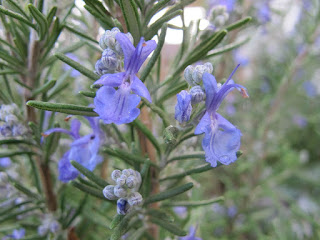Rosmarinus officinalis,
commonly known as rosemary, is a woody, perennial herb with fragrant,
evergreen, needle-like leaves and white, pink, purple, or blue flowers, native
to the Mediterranean region. It is a member of the mint family Lamiaceae, which
includes many other herbs. The name "rosemary" derives from
the Latin for "dew" (ros) and "sea" (marinus), or "dew
of the sea". (Adrian Room, 1988)
According to myth, the Virgin Mary is said to have spread her blue cloak
over a white-blossomed rosemary bush when she was resting, and the flowers
turned blue. The shrub then became known as the "Rose of Mary".
Rosemary was considered sacred to ancient Egyptians, Romans and Greeks. (ANZAC
Day Commemoration Committee, 1988) Since ancient Roman times the herb was used
in burial rites for this reason, to several accounts of funerals in England
where mourners traditionally tossed bouquets of rosemary on top of coffins.
Rosemary is a herb that has long been associated with remembrance and death. In
this respect, rosemary is probably best associated with Shakespeare’s Hamlet,
Act 4, Scene 5; “Ophelia in her madness names plants that were known for
their capacity to ease pain, particularly inwardly felt pain” – “There’s
rosemary, that’s for remembrance; pray, love, remember.”
Rosemary is at home in
Mediterranean dishes and pairs perfectly with lamb, chicken, potatoes, bread
and tomatoes. Nigella Lawson has taken the time to create this amazing
Shakespearean Rosemary Remembrance Cake, recipe can be found below.
INGREDIENTS
FOR THE FILLING
1 eating apple (approx
180g in weight)
2 sprigs fresh rosemary (1
small and 1 long)
1 teaspoon sugar
zest and juice of half a lemon
1 teaspoon butter
FOR THE CAKE BATTER
225 grams butter
150 grams sugar (plus 1
tablespoon)
3 large eggs
300 grams flour
2 teaspoons baking powder
METHOD
Peel, core and roughly
chop the apple and put into a saucepan with the small sprig of rosemary, the
teaspoon of sugar, the lemon zest and juice, and butter. Cover the pan and cook
on a low heat for 4-8 minutes until the apple is soft. How long this takes
really depends on the variety of apple you're using. Coxes cook the fastest,
and are good here.
Leave to cool, and fish
out the rosemary sprig when it is cold.
Preheat the oven to 170°C.
Line a 450g loaf tin with a loaf liner, or butter and line the bottom with
baking parchment.
Put the cooled apple into
a food processor and blitz to a pulp. Then add the butter, 150g of sugar, eggs,
flour and baking powder and process to a smooth batter.
Spoon and scrape into the
loaf tin and smooth the top. Sprinkle the surface with the remaining tablespoon
of sugar and then lay the long sprig of rosemary along the centre of the cake.
On baking, the rosemary sheds its oil to leave a scented path down the middle
of the cake.
Bake the cake for 50
minutes or until a cake tester comes out clean, then leave to cool on a rack.
Slip the paper-lined cake out of the tin once it is cool.
Works cited
- Room, Adrian (1988). A
Dictionary of True Etymologies. Taylor & Francis. p. 150
- "Rosemary" ANZAC
Day Commemoration Committee (Qld) Incorporated, 1988
- Nigella Lawson
"Feast", 2004



No comments:
Post a Comment